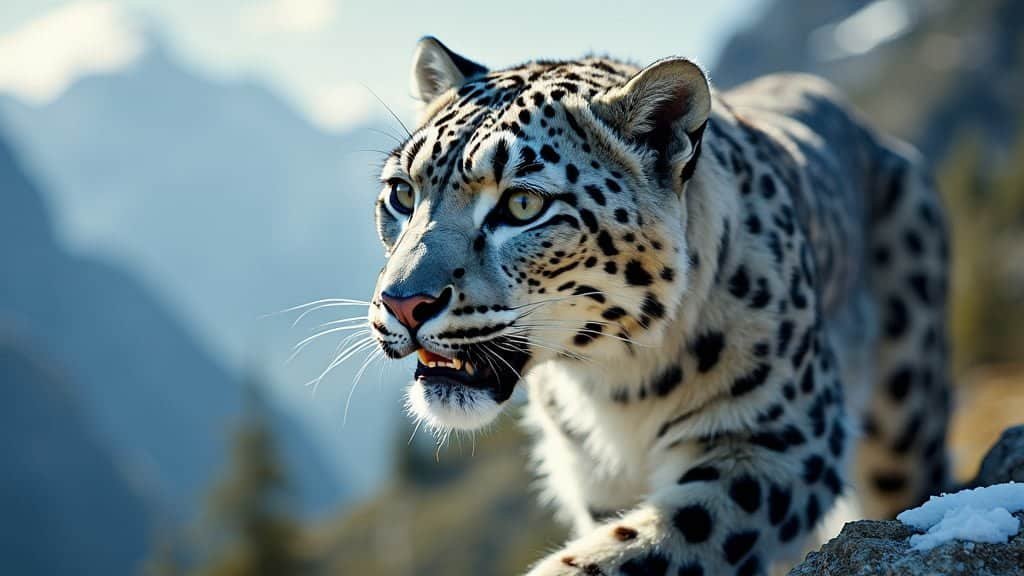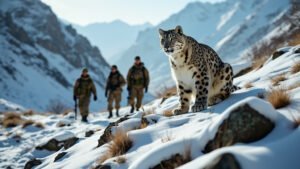Introduction
Snow leopards, known as the “ghosts of the mountains,” face numerous challenges in their fight for survival. Conservation efforts are critical to protect these majestic creatures from poaching, habitat loss, human-wildlife conflict, and climate change
This article delves into the primary obstacles in snow leopard conservation and explores the strategies and measures implemented to overcome these issues. From the impact of illegal hunting to the effects of changing climates, we will examine the multifaceted approach needed to ensure the future of snow leopards in their natural habitat
Impact of Poaching on Snow Leopards
The survival of snow leopards is significantly threatened by poaching. These elusive cats are often targeted for their beautiful fur and bones, which are highly valued in illegal markets. Poaching not only reduces their numbers but also disrupts their genetic diversity and ecological role
Consequences of Illegal Hunting
Poaching has dire consequences for snow leopard populations. Each year, it is estimated that hundreds of snow leopards are killed illegally. The demand for their pelts, bones, and other body parts in traditional medicine and as luxury items fuels this illegal trade
The loss of even a few individuals can have a substantial impact on small, fragmented populations, reducing their genetic diversity and resilience to environmental changes
Anti-Poaching Measures and Their Effectiveness
Efforts to combat poaching include strengthening law enforcement, increasing penalties for wildlife crimes, and enhancing community engagement
Several organizations, such as the Snow Leopard Trust and the Global Snow Leopard & Ecosystem Protection Program (GSLEP), work tirelessly to implement anti-poaching initiatives. These measures include training local rangers, using technology like camera traps and GPS tracking, and fostering community-based wildlife management programs
However, the effectiveness of these measures varies. In some regions, strict enforcement has led to a noticeable decline in poaching incidents. For instance, in Kyrgyzstan, concerted efforts by local and international agencies have resulted in a significant reduction in illegal hunting activities . Yet, in other areas, lack of resources and political instability hinder the implementation and enforcement of anti-poaching laws
Case Studies of Poaching Incidents
Numerous case studies highlight the ongoing struggle against poaching. In Nepal, for example, the deployment of community-based anti-poaching units has been crucial. These units, composed of local volunteers, patrol key areas and report suspicious activities. Their efforts have led to several arrests and the confiscation of illegal wildlife products
In Mongolia, the Snow Leopard Conservation Foundation has implemented a livestock insurance program. This program compensates herders for livestock lost to snow leopards, reducing the incentive to kill leopards in retaliation. Such initiatives help build trust and cooperation between conservationists and local communities, making it more difficult for poachers to operate
Despite these successes, poaching remains a persistent threat. Continued efforts are essential to maintain and build upon the progress made. Collaboration between governments, NGOs, and local communities is crucial to create sustainable and effective anti-poaching strategies
Effects of Habitat Loss on Snow Leopards
Habitat loss is a significant threat to the survival of snow leopards. As human activities encroach upon their natural habitats, these majestic creatures find it increasingly difficult to survive and thrive. Habitat loss not only reduces the space available for snow leopards but also impacts their prey and leads to increased human-wildlife conflicts
Causes of Habitat Loss
The primary drivers of habitat loss for snow leopards include agricultural expansion, infrastructure development, and mining activities
In many regions, pastoral communities expand grazing areas for livestock, leading to overgrazing and degradation of the natural vegetation that snow leopards and their prey rely on. Additionally, the construction of roads, railways, and other infrastructure fragments the landscape, making it difficult for snow leopards to roam and find mates
Mining operations, particularly for minerals and metals, also contribute significantly to habitat destruction. These activities often occur in remote, mountainous regions that overlap with snow leopard habitats. The environmental degradation caused by mining not only destroys the immediate area but also pollutes water sources and disrupts the broader ecosystem
Fragmentation and Its Impact on Leopard Populations
Habitat fragmentation is a severe consequence of habitat loss. It isolates snow leopard populations, restricting their movement and reducing genetic diversity. Fragmented habitats create “islands” where snow leopards are confined to smaller areas, making it harder for them to find food and mates
This isolation can lead to inbreeding, which diminishes the genetic health of the population and increases vulnerability to diseases and environmental changes
Moreover, fragmented habitats force snow leopards into closer proximity with human populations, escalating the risk of conflict. As snow leopards venture into human settlements in search of food, they are more likely to prey on livestock, leading to retaliatory killings by local communities. This human-wildlife conflict further threatens the already endangered snow leopard populations
Efforts to Preserve and Restore Habitats
Several initiatives aim to mitigate habitat loss and restore snow leopard habitats. Protected areas and wildlife corridors are essential strategies in this effort. By establishing and effectively managing protected areas, governments and conservation organizations can safeguard critical habitats from further encroachment and degradation
Wildlife corridors are designed to connect fragmented habitats, allowing snow leopards to move freely between different areas. These corridors are crucial for maintaining genetic diversity and enabling snow leopards to find food and mates without coming into conflict with humans
For example, in the Indian Himalayas, the establishment of wildlife corridors has shown positive results in facilitating snow leopard movement and reducing human-wildlife conflict
Community-based conservation programs also play a vital role. Engaging local communities in conservation efforts through education, sustainable livelihood projects, and participatory land management helps build support for snow leopard conservation
Programs that provide alternative sources of income, such as ecotourism and handicrafts, reduce the dependence on livestock and mitigate the pressure on snow leopard habitats
In some regions, reforestation projects aim to restore degraded habitats. Planting native vegetation helps rebuild ecosystems and provides cover and prey for snow leopards. These projects require long-term commitment and collaboration between conservationists, governments, and local communities to ensure their success
Despite these efforts, challenges remain. Limited funding, political instability, and competing land-use priorities often hinder the implementation of effective habitat conservation measures. Continuous monitoring, adaptive management, and international cooperation are essential to address these challenges and secure a future for snow leopards in their natural habitats
Human-Wildlife Conflict
Human-wildlife conflict is a major challenge in snow leopard conservation, often leading to negative outcomes for both snow leopards and local communities
As human populations grow and encroach upon snow leopard habitats, encounters between humans and these elusive cats become more frequent, resulting in livestock predation and retaliatory killings
Incidents of Livestock Predation
Livestock predation by snow leopards is a common issue in mountainous regions where pastoralism is the primary livelihood
Snow leopards may prey on livestock such as sheep, goats, and yaks, particularly when their natural prey is scarce due to habitat loss or overhunting. This predation leads to significant economic losses for herders, who rely on livestock for their income and sustenance
For example, in the Himalayas, snow leopards are known to attack livestock during harsh winter months when natural prey is harder to find. A single attack can result in the loss of several animals, creating substantial financial hardship for herders. These incidents often provoke retaliatory killings, where herders poison or shoot snow leopards to protect their livelihood
Strategies for Mitigating Conflict
Effective strategies to mitigate human-wildlife conflict are crucial for the long-term survival of snow leopards. One successful approach is the implementation of livestock insurance programs
These programs compensate herders for livestock lost to snow leopards, reducing the financial burden and decreasing the motivation for retaliatory killings. For instance, the Snow Leopard Trust has established such programs in Mongolia and India, helping to foster coexistence between herders and snow leopards
Improving livestock protection measures is another key strategy. Constructing predator-proof corrals, using guard dogs, and employing herders to monitor and protect livestock during grazing can significantly reduce predation incidents. In Kyrgyzstan, the use of traditional herding practices combined with modern techniques has effectively decreased livestock losses to snow leopards
Community education and awareness campaigns are also vital. By educating local communities about the ecological importance of snow leopards and promoting non-lethal methods of conflict resolution, conservation organizations can build local support for snow leopard protection
Training workshops, school programs, and community meetings are common methods used to spread awareness and encourage participation in conservation efforts
Community-Based Conservation Initiatives
Community-based conservation initiatives involve local people in the planning and implementation of conservation strategies, ensuring that their needs and perspectives are considered. These initiatives can include participatory land management, alternative livelihood projects, and benefit-sharing mechanisms
For example, in Nepal, the Snow Leopard Conservancy has initiated community-based tourism projects that provide alternative income sources for local people. By promoting eco-tourism activities such as guided wildlife tours and homestays, these projects create economic incentives for communities to protect snow leopards and their habitats
Benefit-sharing mechanisms, such as revenue from eco-tourism or payments for ecosystem services, also help to align the interests of local communities with conservation goals. When communities receive direct benefits from conservation activities, they are more likely to support and participate in these efforts
Another successful example is the Himalayan Homestay Program, which offers tourists the opportunity to stay with local families and experience traditional culture while exploring snow leopard habitats. The revenue generated from this program supports community development projects and provides financial incentives for snow leopard conservation
Despite these efforts, challenges remain in mitigating human-wildlife conflict. Limited resources, cultural differences, and varying levels of community engagement can affect the success of conservation programs. Continuous dialogue, adaptive management, and sustained funding are essential to address these challenges and promote harmonious coexistence between humans and snow leopards
Climate Change and Snow Leopard Habitats
Climate change is an emerging threat that exacerbates the challenges snow leopards face in their high-altitude habitats. Changes in temperature and precipitation patterns can significantly impact the ecosystems where snow leopards live, affecting both the leopards and their prey
Changing Climatic Conditions in Snow Leopard Ranges
Snow leopards inhabit mountainous regions of Central and South Asia, including the Himalayas, the Tibetan Plateau, and the Altai Mountains. These areas are highly sensitive to climate change, experiencing rising temperatures, altered precipitation patterns, and increased frequency of extreme weather events
Rising temperatures are causing glaciers to melt and altering snow cover, which affects the availability of water resources in these regions. The reduction in snow and ice not only impacts the water supply for both wildlife and human communities but also changes the structure of the habitats snow leopards depend on
Altered precipitation patterns can lead to unpredictable weather conditions, affecting the growth of vegetation and the availability of prey species such as blue sheep and ibex. For example, heavy snowfall in winter can bury vegetation, making it difficult for herbivores to find food, which in turn affects the snow leopards that prey on them
Adaptive Measures for Habitat Conservation
To address the impacts of climate change on snow leopard habitats, adaptive conservation measures are essential
One approach is to enhance the resilience of ecosystems through habitat restoration and connectivity. By restoring degraded habitats and creating wildlife corridors, conservationists can ensure that snow leopards have access to larger, connected areas that provide sufficient resources and allow for natural movement and migration
Protected areas play a crucial role in this strategy. Expanding and effectively managing protected areas can help safeguard critical habitats from further degradation and provide refuges for snow leopards and their prey
In regions like the Indian Himalayas and the Tibetan Plateau, efforts are underway to establish and maintain protected areas that cover key snow leopard habitats
Climate-smart conservation practices involve integrating climate change projections into conservation planning. This includes monitoring climatic changes and their effects on ecosystems, as well as developing strategies to mitigate these impacts
For example, conservation organizations are working with local communities to implement sustainable land-use practices that reduce habitat degradation and increase ecosystem resilience
Research on Long-Term Climate Impacts
Research on the long-term impacts of climate change is vital for developing effective conservation strategies. Studies conducted by institutions such as the International Union for Conservation of Nature (IUCN) and the Snow Leopard Trust provide valuable insights into how climate change affects snow leopard populations and their habitats
Recent research has highlighted the importance of genetic diversity in enabling snow leopards to adapt to changing environmental conditions
Maintaining healthy, genetically diverse populations can enhance the ability of snow leopards to cope with climate-induced changes in their habitats. Conservation efforts that focus on protecting and connecting populations are crucial in this regard
Additionally, research on prey dynamics and vegetation patterns helps to understand the broader ecosystem impacts of climate change. For instance, studies on the effects of changing snowfall patterns on herbivore populations can inform management practices aimed at ensuring sufficient prey availability for snow leopards
Collaboration between scientists, conservationists, and local communities is essential for effective climate change research and adaptation. Local knowledge and observations can complement scientific data, providing a more comprehensive understanding of climate impacts and informing adaptive management practices
Despite ongoing research and conservation efforts, addressing the impacts of climate change on snow leopard habitats remains challenging. Continued investment in research, adaptive management, and international cooperation is essential to mitigate these impacts and ensure the long-term survival of snow leopards in a changing climate
Conservation Strategies and Their Effectiveness
Conserving snow leopards involves a combination of strategies that address the various threats they face, including poaching, habitat loss, human-wildlife conflict, and climate change
Effective conservation requires coordinated efforts from governments, non-governmental organizations (NGOs), local communities, and international bodies
Overview of Conservation Programs
Numerous conservation programs have been implemented to protect snow leopards and their habitats. Organizations such as the Snow Leopard Trust, Panthera, and the Global Snow Leopard & Ecosystem Protection Program (GSLEP) lead many of these initiatives. These programs focus on research, anti-poaching efforts, habitat preservation, and community engagement
The GSLEP, launched in 2013, is a collaborative effort involving 12 snow leopard range countries. Its goal is to secure 20 snow leopard landscapes by 2020. This ambitious program emphasizes international cooperation, combining resources and expertise to address the multifaceted challenges of snow leopard conservation
Success Stories and Challenges
There have been notable successes in snow leopard conservation. In areas where anti-poaching measures have been strictly enforced, snow leopard populations have shown signs of recovery
For example, in Mongolia’s Tost Tosonbumba Nature Reserve, stringent anti-poaching laws and community patrols have led to a decrease in illegal hunting activities
Community-based conservation initiatives have also yielded positive results. In Nepal, the Snow Leopard Conservancy’s programs that involve local communities in monitoring and protecting snow leopards have reduced poaching incidents and fostered a sense of ownership among villagers
However, challenges persist. Limited funding, political instability, and lack of resources can hinder conservation efforts. Additionally, balancing the needs of local communities with conservation goals remains a complex issue. In some regions, human-wildlife conflict continues to pose a significant threat to snow leopard populations
Role of Technology in Conservation Efforts
Technology plays a crucial role in modern conservation efforts. Camera traps, GPS collars, and drones are used to monitor snow leopard populations and gather data on their behavior and movements
These tools provide valuable insights that inform conservation strategies and allow for more effective management of snow leopard habitats
For instance, camera traps set up in remote areas have captured rare footage of snow leopards, helping researchers estimate population sizes and understand their distribution. GPS collars enable scientists to track the movements of individual leopards, identifying critical habitats and migration corridors
Drones are increasingly used for aerial surveys, providing a comprehensive view of large and inaccessible areas. They help in mapping habitats, monitoring environmental changes, and detecting illegal activities such as poaching and habitat destruction
Conservation organizations also use data analytics and modeling to predict the impacts of climate change on snow leopard habitats. By integrating climatic data with ecological information, they can develop adaptive management plans that enhance the resilience of snow leopard populations
International Collaboration and Funding
International collaboration is essential for the success of snow leopard conservation. The transboundary nature of snow leopard habitats means that no single country can effectively protect these cats on its own
Collaborative efforts like the GSLEP and partnerships between NGOs and governments help pool resources and share knowledge
Securing funding for conservation projects is a continuous challenge. Many conservation programs rely on grants, donations, and international funding mechanisms. Innovative funding approaches, such as conservation trust funds and payments for ecosystem services, are being explored to ensure sustainable financing for long-term conservation efforts
Despite the progress made, ongoing support and commitment from the global community are crucial to overcoming the challenges facing snow leopard conservation. Continuous investment in research, technology, and community engagement, along with strong political will and international cooperation, is necessary to secure the future of snow leopards in their natural habitats
Conclusion
Snow leopards face a myriad of challenges that threaten their survival, including poaching, habitat loss, human-wildlife conflict, and the impacts of climate change
Effective conservation requires a multifaceted approach that addresses each of these threats through coordinated efforts among governments, NGOs, local communities, and international organizations. Anti-poaching measures, habitat restoration, community-based conservation, and technological advancements are all crucial components of this strategy
Despite significant successes in various regions, ongoing challenges such as limited funding and political instability highlight the need for sustained commitment and international collaboration. By continuing to invest in research, adaptive management, and community engagement, we can work towards ensuring a future where snow leopards thrive in their natural habitats











